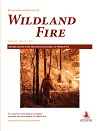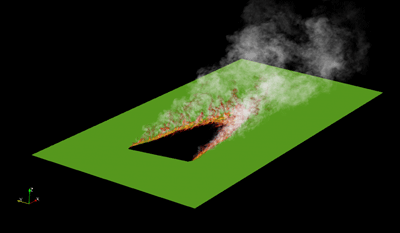
International Journal of Wildland Fire
Volume 32 Number 12 2023
This article presents a comprehensive literature review that assesses the current state of social science research related to wildfire adaptation in the southwestern USA, organised using the Fire Adapted Communities Framework to identify key themes and future research needs that can inform more intentional and strategic adaptation across scales and contexts.
WF23102 Abstract | WF23102 Full Text | WF23102PDF (1.3 MB) | WF23102Supplementary Material (472 KB) Open Access Article
WF22098Occupational and environmental factors influencing morale of United States federal wildland firefighters
This paper presents the results of a broad survey of US federal wildland firefighters. Our results highlight needs for reform in hiring practices, offer insight into retention and suggest a need for expanded mental healthcare.
WF22098 Abstract | WF22098 Full Text | WF22098PDF (1 MB) | WF22098Supplementary Material (472 KB) Open Access Article
WF23092A novel method to evaluate safe heat exposure distance for firefighters under thermal radiation conditions
To evaluate safe heat exposure distance (SHED) in wildland fire environments, we used a test apparatus to measure it in a small-scale experiment, and the SHED data of fire environments were obtained by establishing the conversion equation of heating source distances that connected a small-scale test with a fire environment.
WF23053Fighting wildfires: predicting initial attack success across Victoria, Australia
 , S. Deutsch, E. Tartaglia, C. Huston and A. G. Stephenson
, S. Deutsch, E. Tartaglia, C. Huston and A. G. Stephenson
Models were developed to estimate the probability of initial attack success in grassland-, forest- and shrubland-dominated vegetation types. The models include variables describing weather conditions, travel delay, slope and distance from roads, and they can be used as an early prompt to plan for protracted suppression.
WF23022Using PODs to integrate fire and fuels planning
 , Tyler A. Beeton, Courtney A. Schultz
, Tyler A. Beeton, Courtney A. Schultz  , Michael D. Caggiano and Michelle S. Greiner
, Michael D. Caggiano and Michelle S. Greiner
Potential Wildfire Operational Delineations (PODs) were developed as a pre-season planning tool to promote safe and effective fire response. Past research on PODs has identified uses in an incident management context and explored avenues to strengthen its approach. This article explores how PODs are integrating fire and fuels planning.
WF22225A high-resolution large-eddy simulation framework for wildland fire predictions using TensorFlow
 , Matthias Ihme, Rod R. Linn, Yi-Fan Chen, Vivian Yang, Fei Sha, Craig Clements, Jenna S. McDanold and John Anderson
, Matthias Ihme, Rod R. Linn, Yi-Fan Chen, Vivian Yang, Fei Sha, Craig Clements, Jenna S. McDanold and John Anderson
This work presents a new wildfire simulation framework implemented in TensorFlow for landscape-scale wildfire simulations with physical representation of the combustion at affordable computational cost on the Tensor Processing Unit (TPU) hardware architecture. We validate this simulation framework and demonstrate its efficiency with simulations of the prescribed fire experiment.
WF22225 Abstract | WF22225 Full Text | WF22225PDF (4.8 MB) Open Access Article
Merging fires are extremely hazardous in wildfire spread. This work simulated the merging of parallel fires and compared them with lab-scale experiments. We gained new insights into how parallel fires interact with their surroundings. This research will help to improve strategies in wildfire management and reduce risks to firefighters and the public.
Laboratory experiments undertaken in dry eucalypt forest litter in a large combustion wind tunnel investigated the interactions between two non-intersecting oblique lines of fire at two angles of incidence under both calm and wind conditions. Fires burning with wind behaved significantly different to controls and non-wind fires.
WF23080Mapping the probability of wildland fire occurrence in Central America, and identifying the key factors
Wildland fires are natural events that are part of the ecology of forests in Central America. However, a lack of knowledge hinders the implementation of intervention strategies. Our results show that a combination of human-driven and physical variables relate to the probability of wildland fire occurrence.
WF23026Drivers of wildfire burn severity in the montane rainforests of northern Vietnam
Factors influencing burn severity in tropical montane forest fires are poorly understood. We found that higher burn severity occurred under topographic conditions associated with steeper slopes and drier aspects, which promote greater fuel dryness. Burn severity also increased with elevation, possibly owing to greater vulnerability of tree species to fire.
WF22156Effect of tree wood density on energy release and charcoal reflectance under constant heat exposure
 , Ted R. Feldpausch
, Ted R. Feldpausch  , Ben Hur Marimon Junior, Edmar A. de Oliveira and Claire M. Belcher
, Ben Hur Marimon Junior, Edmar A. de Oliveira and Claire M. Belcher
The reflectance of charcoal may indicate how much heat it has been exposed to, making it a potential measure of fire severity, but the influences of other factors first need to be understood. Comparing 25 species, we found that denser wood produced charcoal with higher reflectance.
WF23136Impact of fire suppressant on seed germination and seedling emergence of native and introduced flora from a Western Australian eucalypt woodland
This study assessed the impact of a fire suppression chemical (Phos-Chek) on native and introduced species found in Western Australia. It observed that effects vary among species, with an overall negative impact to germination and emergence.
WF23107Delayed effect of thermal treatment on breaking physical seed dormancy: intrapopulation variation and implications for soil seed banks
Plant species from fire-prone ecosystems may have various adaptations to fire. High temperatures reached in the soil during wildland fires stimulate the germination of hard-coated seeds. The effects of thermal shock are especially evident during the first 3 years after fire and they vary according to the seed mother plant.
WF23031Grasshopper abundance and offtake increase after prescribed fire in semi-arid grassland
 , Carissa L. Wonkka
, Carissa L. Wonkka  , Lance T. Vermeire and David H. Branson
, Lance T. Vermeire and David H. Branson
Rangeland grasshoppers congregate in areas that have been recently burned to take advantage of higher crude protein, and generally avoid consuming grass in nearby unburned areas.
WF23031 Abstract | WF23031 Full Text | WF23031PDF (821 KB) Open Access Article




